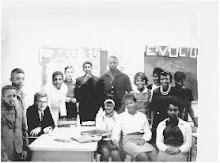Tips for The Professional Teacher:
Converting an Incremental Skill Practice Activity
to a Generative Strategy Acquisition Lesson
Presume that a small group of seventh grade students are doing comprehension practice work in SRA's Reading for Understanding Kit (Thelma Thurstone, 1969). The instructional task is to select the best word or phrase to complete a sentence or brief paragraph.
Sample (card 08, #5)
Fixed stars actually move about in space but the ancients who first saw and named them were unable to discern their:
a. arrangement b. size c. motion d. light
(Correct answer is c. motion, the key words in the sentence are "move about")
The teacher, usually supervises by walking about and monitoring their work while students do such exercises, and self-correct them, This, typically, involves pausing when a student is making errors and helping the student to puzzle out the correct answer.
As described, this is a solid incremental learning activity involving close-knit analytical reading, self-pacing, self-scoring, and teacher monitoring. It is not generative, however, since feedback is shallow, there is no incentive to think deeply, and whenever the teacher stops at a desk there is the implicit suggestion that the student has erred. This causes most students to become distracted and to terminate thinking in order to solve the new social problem created by the impression that the teacher only stops to talk to those who are weak and wrong. To overcome this, students typically will quickly (and mindlessly) select another answer so that, if correct, the teacher will keep moving.
This incremental lesson can become somewhat more generative by a little fine-tuning. In this case, the teacher need only be sure that when stopping at a desk, that she should ask a student to explain some answers that are correct as well as incorrect.
This slight adjustment can result in several positive and generative outcomes. First, it resets the impression that the teacher stops only when errors are being made. Second, it gives a student an opportunity to occasionally demonstrated competent thinking. Thirdly, it gives the teacher a chance to reinforce and refine solid thinking. Fourth, it develops a stronger sense of self-examination of ones own thinking and responding, the sine qua non of all educational processes.*
§ * Excerpt From: Manzo & Manzo: Literacy Disorders: Holistic Diagnosis and Remediation (with U. Manzo). Harcourt, Brace, Jovanovich (1993). (Now Wadsworth) (2nd edition in progress; publication, 2003)

No comments:
Post a Comment